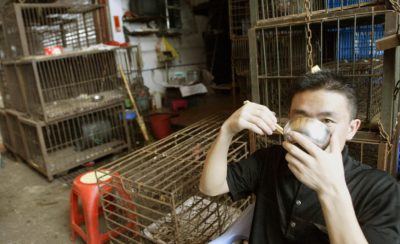
How did the deadly coronavirus jump from animals to humans? And what steps can we take to guard against it in the future?
The exact chain of events will likely never be known for sure, but it’s believed the now-global coronavirus epidemic began when someone in Wuhan ate wildlife, possibly a snake, that had picked up the virus from a bat.
It’s rare for humans to fall sick to animal diseases. But it can happen if the two species are in close physical contact, from a bite or a scratch, for example —or when the infected animal is dinner. Once the virus has taken hold inside a human, it can adapt to its new host and spread easily to other humans through coughing or sneezing.
The world’s wildlife food trade is an understudied, rarely documented part of the gray economy that thrives in many countries. There are thousands of wildlife markets throughout Asia and Africa, but the vast majority are so small and innocuous that they fly under the radar of government policies.
“There’s usually little or no supervision of conditions or restrictions on what type of species can be sold,” says Peter Knights, the CEO of the conservation group WildAid.
Animals are transported to market alive, so that buyers can be assured they are fresh and the sellers can save money on refrigeration. This is what makes wildlife markets a public health nightmare.
“You get many different species in appalling conditions,” says Knights. “The animals are stressed, which makes them more susceptible to illness, and the markets are filthy, with stacked cages, so you have animals that are literally defecating on each other. They are shedding live viruses. You could not design a more efficient system to communicate disease than these markets.”
So why do they remain in operation?
“All societies have eaten bushmeat at some point, including our own,” says Knights. “But then societies move on to safer forms of consumption through domesticated animals that are slaughtered in sanitary conditions, hopefully sanitary, so viruses are usually not alive when they reach the consumer.”
Some argue that wildlife meat provides protein to the impoverished who cannot afford proper livestock, but Knights and other conservationists dispute this, contending that most wildlife is purchased because consumers simply prefer it over the food they can buy in stores.
“It still has a bit of cache, for some,” says Knights. “It’s considered a special treat.”
But with the coronavirus outbreak in the news, that may change, as governments realize yet again that unregulated consumption of wild animals can cause deadly epidemics, as well as huge financial losses through closed businesses, restricted travel and costly health services.
“All the money ever made through the bush trade was wiped out on the first day of the coronavirus epidemic,” says Knights. “It’s a marginalized, low-income business — very few people are benefiting financially while they are incurring massive costs to others. I’m sure many in China are thinking, ‘Why is this happening again? We can’t keep doing this.’”
The SARS epidemic that started under similar circumstances in China in 2003 is said to have cost world markets $40 billion. The price tag for the coronavirus could be worse.
Knights believes this is the perfect time to end the wildlife meat trade forever.
As a model program, he points out how China put a major dent in the global trade in shark fins and rhino horns. The market for fins has dropped 80 percent in three years, mostly because of a massive public education campaign China launched against once-popular shark fin soup, as well as trade restrictions.
“With that major educational campaign, people in China no longer want to eat shark fin soup,” Knights says. “The demand has all but disappeared.”
The trade in rhino horn has dropped 75 percent in approximately the same period. Horns that once sold for $66,000 a kilo are now worth closer to $10,000, Knights says, because of lowered demand and increased enforcement.
“You can’t persuade everyone,” he concedes, “but you can minimize demand for wildlife. Now is the time to do it.”
“I suspect that we are lucky the coronavirus outbreak is so far not as virulent as it could be,” Knight contends. “But it’s big enough to create an understandable fear to get people to say: ‘Enough is enough. This is not what modern urban societies do, because it’s too dangerous. Having these foods is not worth the risks.”
Some experts say that change was in process even before the coronavirus outbreak. Anecdotal evidence suggests younger people are less likely to crave wildlife delicacies than their parents or grandparents.
Knights says, however, that a global push is particularly needed to end meat markets in urban areas, where people congregate and travel, making epidemics more likely. He suspects people in villages will continue the practice, catching the animals they eat themselves, but points out that they are less connected to the rest of the world.
“Villages tend to be more isolated, there’s less travel, so it’s less likely to create an epidemic.”
Stay in touch and get the latest WildAid updates.
SIGN UPAbout WildAid
WildAid is a non-profit organization with a mission to protect wildlife from illegal trade and other imminent threats. While most wildlife conservation groups focus on protecting animals from poaching, WildAid primarily works to reduce global consumption of wildlife products such as elephant ivory, rhino horn and shark fin soup. With an unrivaled portfolio of celebrity ambassadors and a global network of media partners, WildAid leverages more than $308 million in annual pro-bono media support with a simple message: When the Buying Stops, the Killing Can Too.
Journalists on deadline may email communications@wildaid.org